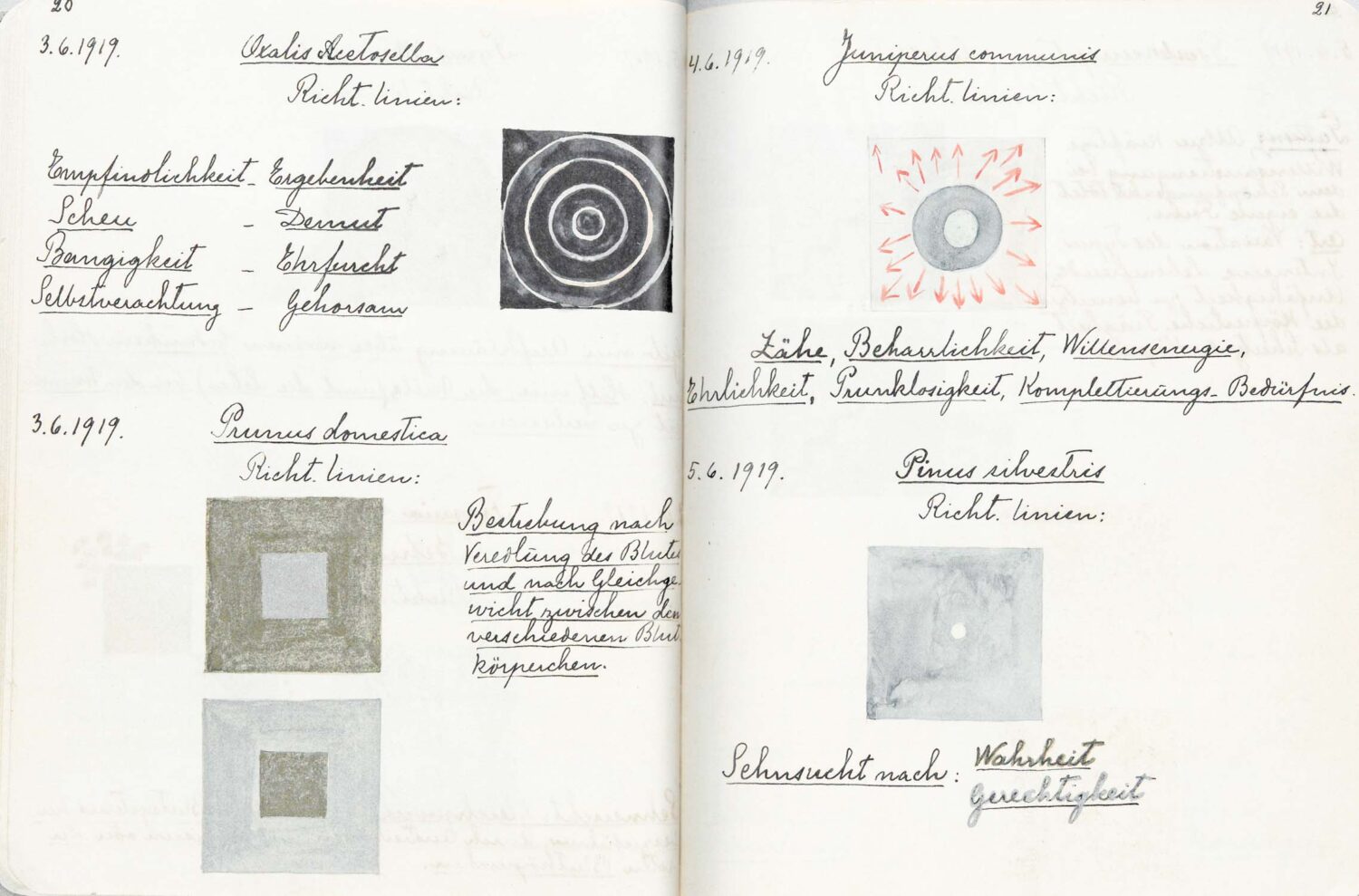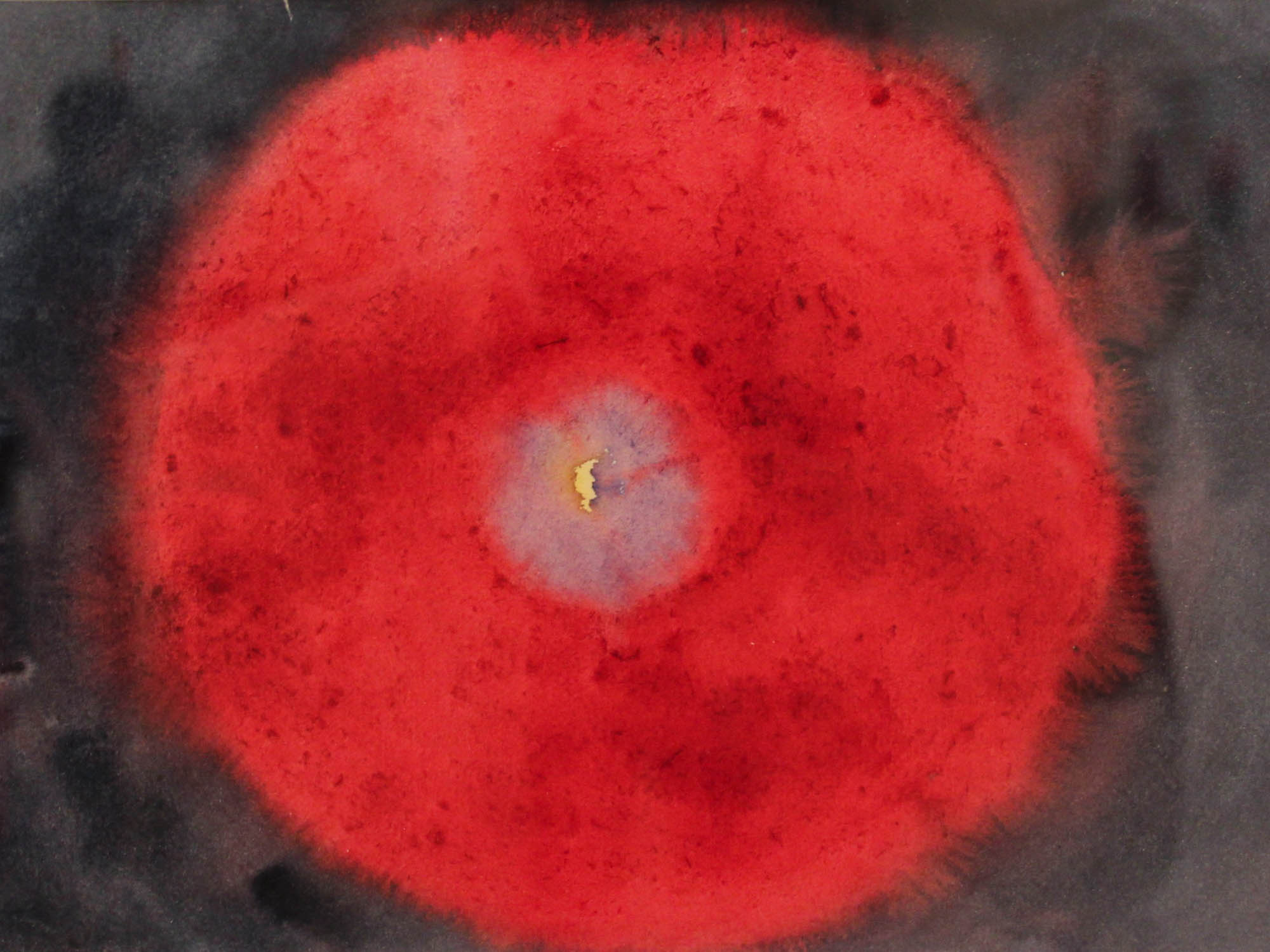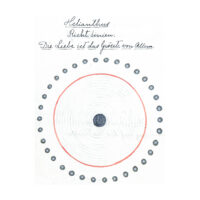An excerpt of a lecture given at the opening of a Hilma af Klint exhibit at Lightforms in Hudson, New York, on March 8, 2020, by David Adams, Ph.D.
When her mother died in 1920, af Klint felt more free to travel and in September began to undertake regular journeys to Dornach, where she joined the Anthroposophical Society. Over eight or nine separate visits from 1920 to 1925 (the year of Steiner’s death) she spent altogether more than a year of time in Dornach. There she could observe the style of painting inaugurated by Rudolf Steiner on the Goetheanum building cupola murals (Figure 34), learn something about his new approach of “painting out of the color,” and how Steiner was extending Goethe’s color theory through such concepts as image and luster colors. She may have attended his lectures specifically on color in Dornach, May 6-8 in 1921.1 She had conversations with Steiner and attended various lectures by him and about 36 of her later notebooks are full of extensive notes from these. All she was learning in Dornach needed to be digested and incorporated into her working methods, and seemingly, led her to stop painting again for a couple of years until 1922.
Especially from 1922 onward for the rest of her artistic life, she changed her painting to working in a wet-on-wet watercolor technique, creating more than 200 watercolors from a more anthroposophical approach. She did not just externally copy a “Goetheanum style” of painting but worked at penetrating the inner nature of colors and how form can arise from their interactions as well as with a clairvoyant, spiritual-scientific research into the natural world that also used art as a means of recording or reporting the results of such investigations. Some of her later paintings – especially from the series On the Viewing of Flowers and Trees painted between July and October, 1922 – seem to be based on plant-related meditative exercises described in Steiner’s basic book How to Know Higher Worlds.2
Exercise 1. In one of the first and most basic exercises in the book, Steiner says to patiently and devotedly practice observing life in the natural world that is growing, flourishing, developing, and blooming and suggests we eventually will come to feel the quality of these phenomena as similar to a sunrise.
Exercise 2. By contrast, he then instructs meditants to similarly observe natural phenomena of fading, withering, and decaying and suggests these will be experienced like the slow rising of the moon.
When practiced long enough (which can vary for each person), these exercises aim to build inner, spiritual organs of clairvoyance (the chakras or lotus flowers) that will enable one to experience the invisible astral plane (“soul world”) that lies behind the world we experience with our ordinary senses. Then the meditant will become aware of certain “forms of feeling,” attached to each process, that is, astral forms, lines, and figures associated or expressive of each of the two contrasting phenomena of the living world of nature, especially in plants. Some of Hilma af Klint’s paintings from this 1922 series of watercolors seem to show these opposite “botanical” phenomena:

Figure 1 (see title image) of a birch tree seems more sprouting and full of life. Figure 2 seems to show pairings of the two different tendencies in a single picture.
Exercise 3. Steiner then directs a meditant to first comparatively observe and then call up in inner mental images the different forming forces and related feelings of stone, plant, and animal. He says this helps form spiritual organs of perception to grasp purely spiritual colors (similar to but different than colors of the ordinary sense world) expressive of each natural kingdom. For plants, he describes a typically greenish color turning to an ethereal pink.
Exercise 4. Another plant-related meditative exercise from Steiner’s How to Know the Higher Worlds asks the meditant to physically observe and then inwardly imagine a plant seed, say a sunflower or squash seed, gradually building up in inner mental imagery and inner feeling the invisible forces in the seed as they will gradually unfold in that specific plant as it grows. If one more and more feels this with intensity, the inner image of the seed will come to appear as if enveloped in a small luminous colored flamelike cloud or aura with certain colors.
Exercise 5. Then one must practice the opposite imagination: Picture the fully developed plant that will eventually wither and die but will produce seeds. Consider that something one cannot see guards the plant from disappearing completely into nothing. There is something in the plant that we cannot see physically. Out of this feeling the meditant will gradually come to perceive a spiritual flame-form or aura, larger and differently colored than with the seed. (typically greenish-blue in the center and yellowish-red at the outer edges). In my experience with these exercises, each specific species of plant generates somewhat different auric color patterns.
These meditative plant studies seem to have helped lead to her most extensive project from the later “anthroposophical” period: notebooks presenting extended, unique “spiritual-scientific” botanical studies created especially during 1919-1920, annotated in German, and recording the characters and qualities of individual plants. Figure 3 shows a typical two-page spread from one of her notebooks as one example of the format she finally settled on.

All of these studies employed a combination of careful meditative observation, clairvoyant perception, and artistic expression – titled Flowers, Mosses, and Lichens. For these botanical studies, she developed an unusual threefold diagrammatic language to capture the qualities of each plant, with each species given either a full or half page, reflecting a very different way of experiencing nature than that used in classical botany:
- The plant’s identifying scientific name (seemingly replacing the realistic depiction in the violets painting),
- A small drawing/painting of spiritually perceived “directional lines” either as free-floating symbols or often a square (or oval) divided into 4 quadrants, usually with expressive colors, lines, and forms; and
- A short verbal description of the plant’s emotional or spiritual qualities (sometimes seemingly pointing to therapeutic properties).
It is possible that this plant research was a task given to her by Steiner, but we have no evidence of that. Later in one notebook, it was written: “The images are seen on the astral plane.”3

In these diagrammatic plant pictures from 1919-1920, we seem to see elemental forces, colors, structures, and tendencies that expand and contract. We don’t know why she so often employed a quadrant format within the square or oval shapes depicting the plants’ “directional lines.” Perhaps they represent four levels of reality in which the plant exists or maybe four stages of plant growth.
I will just present a few specific examples here, as visual images and/or verbal descriptions, indicating the English name of the plant and the page number for it in af Klint’s notebook:
- Tussilago farfara (coltsfoot): “Through the energy of the will from light to darkness, and from light to greater light.” (p. 3)4
- Prunus spinosa (blackthorn): “The incorruptibility of the law. The inexhaustibility of the gospel.” (p. 14)
- Figure 45: Prunus cerasus (sour cherry): “Liberator of the intestinal bacteria and infusiora that are caused by animal foodstuffs.” (p. 17, depicted in figure 3; remember that af Klint was a vegetarian.)
- Pyrus communis (European or common pear): “Give me enlightenment about my astral weakness. Help me to improve the kidneys of humanity.” (p. 18, depicted in figure 4)
- Figure 46: Fragaria vesca (wild strawberry): “Liberator. Longing: To cause balance within the blood system by driving out either the white or red blood cells.” (p. 19)
- Figure 47: Juniper: “Tenacity, persistence, energy of the will, honesty, lack of ostentation, need for completion.” (p. 21, depicted in figure 5 below)
- Figure 48: Polygala vulgaris (milkwort): “Humility. Caution. Accuracy. Timing.” (p. 25)
- Figure 49: Viburnum opulus (European cranberry bush): “Disobedience” (p. 28).
- Sedum telephium (Purple Emperor, a succulent):“Tireless. In special contact with the spirits of the air.” (p. 41)
- Tulipa (tulip): “Physical strength is a necessary asset. The body is dependent on the etheric body.” p. 51)
- Figure 50: Helianthus annus (sunflower): “Love is the greatest of all. The strength not to forget God always comes from love.” (p. 44)
- Figure 51: Hylocomium triquetrum (“Bryophyte”) (p.72) One of the woodland mosses (included in the original copy of the notebook but not in the one on display here) is even represented by a four-note rising melody in a musical bar sign (lower right) labeled “The collective sound wave of the mosses.”5

This sketchbook book also includes a few other, not directly botanical topics, including one butterfly, one mosquito, one spider, a form for each Scandanavian country, a diagram of the kingdoms of nature, and one of comparative qualities of the four gospels. It would be interesting if a therapist or medical researcher tried applying some of af Klint’s plant indications to determine if the bodily and psychological therapeutic effects af Klint described could be documented in practice, maybe after the manner of homeopathic herbalism, the Bach flower remedies, or the anthroposopical remedies.
The full article from which this was excerpted can be found at Lightforms Art Center
Title image Figure 1: Hilma af Klint, “Birch” from On the Viewing of Flowers and Trees, 1922, watercolor. Image source: Wikimedia Commons.
Footnotes
- Rudolf Steiner, trans., John Salter, Colour (London: Rudolf Steiner Press, 1971; GA 291; or see the later, expanded edition, trans. John Salter and Pauline Wehre, Colour (London: Rudolf Steiner Press, 1992; GA 291).
- Rudolf Steiner, trans., Cristopher Bamford, How to Know Higher Worlds: A Modern Path of Initiation (Hudson, NY: Anthroposophic Press, 1994: GA10). Also translated as Knowledge of Higher Worlds and Its Attainment.
- Burgin, Notes and Methods, p. 233.
- All descriptions of the plants are quoted from the translations in Burgin, Notes and Methods, pp.165-244.
- Burgin, Notes and Methods, p. 236.













